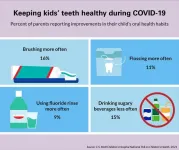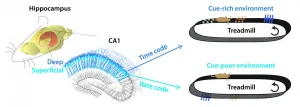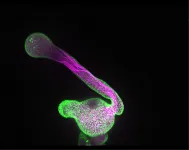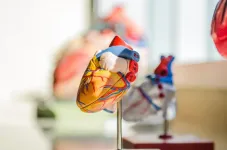(Press-News.org) When the Covid-19 pandemic struck in early 2020, doctors and researchers rushed to find effective treatments. There was little time to spare. "Making new drugs takes forever," says Caroline Uhler, a computational biologist in MIT's Department of Electrical Engineering and Computer Science and the Institute for Data, Systems and Society, and an associate member of the Broad Institute of MIT and Harvard. "Really, the only expedient option is to repurpose existing drugs."
Uhler's team has now developed a machine learning-based approach to identify drugs already on the market that could potentially be repurposed to fight Covid-19, particularly in the elderly. The system accounts for changes in gene expression in lung cells caused by both the disease and aging. That combination could allow medical experts to more quickly seek drugs for clinical testing in elderly patients, who tend to experience more severe symptoms. The researchers pinpointed the protein RIPK1 as a promising target for Covid-19 drugs, and they identified three approved drugs that act on the expression of RIPK1.
The research appears today in the journal Nature Communications. Co-authors include MIT PhD students Anastasiya Belyaeva, Adityanarayanan Radhakrishnan, Chandler Squires, and Karren Dai Yang, as well as PhD student Louis Cammarata of Harvard University and long-term collaborator G.V. Shivashankar of ETH Zurich in Switzerland.
Early in the pandemic, it grew clear that Covid-19 harmed older patients more than younger ones, on average. Uhler's team wondered why. "The prevalent hypothesis is the aging immune system," she says. But Uhler and Shivashankar suggested an additional factor: "One of the main changes in the lung that happens through aging is that it becomes stiffer."
The stiffening lung tissue shows different patterns of gene expression than in younger people, even in response to the same signal. "Earlier work by the Shivashankar lab showed that if you stimulate cells on a stiffer substrate with a cytokine, similar to what the virus does, they actually turn on different genes," says Uhler. "So, that motivated this hypothesis. We need to look at aging together with SARS-CoV-2 -- what are the genes at the intersection of these two pathways?" To select approved drugs that might act on these pathways, the team turned to big data and artificial intelligence.
The researchers zeroed in on the most promising drug repurposing candidates in three broad steps. First, they generated a large list of possible drugs using a machine-learning technique called an autoencoder. Next, they mapped the network of genes and proteins involved in both aging and SARS-CoV-2 infection. Finally, they used statistical algorithms to understand causality in that network, allowing them to pinpoint "upstream" genes that caused cascading effects throughout the network. In principle, drugs targeting those upstream genes and proteins should be promising candidates for clinical trials.
To generate an initial list of potential drugs, the team's autoencoder relied on two key datasets of gene expression patterns. One dataset showed how expression in various cell types responded to a range of drugs already on the market, and the other showed how expression responded to infection with SARS-CoV-2. The autoencoder scoured the datasets to highlight drugs whose impacts on gene expression appeared to counteract the effects of SARS-CoV-2. "This application of autoencoders was challenging and required foundational insights into the working of these neural networks, which we developed in a paper recently published in PNAS," notes Radhakrishnan.
Next, the researchers narrowed the list of potential drugs by homing in on key genetic pathways. They mapped the interactions of proteins involved in the aging and Sars-CoV-2 infection pathways. Then they identified areas of overlap among the two maps. That effort pinpointed the precise gene expression network that a drug would need to target to combat Covid-19 in elderly patients.
"At this point, we had an undirected network," says Belyaeva, meaning the researchers had yet to identify which genes and proteins were "upstream" (i.e. they have cascading effects on the expression of other genes) and which were "downstream" (i.e. their expression is altered by prior changes in the network). An ideal drug candidate would target the genes at the upstream end of the network to minimize the impacts of infection.
"We want to identify a drug that has an effect on all of these differentially expressed genes downstream," says Belyaeva. So the team used algorithms that infer causality in interacting systems to turn their undirected network into a causal network. The final causal network identified RIPK1 as a target gene/protein for potential Covid-19 drugs, since it has numerous downstream effects. The researchers identified a list of the approved drugs that act on RIPK1 and may have potential to treat Covid-19. Previously these drugs have been approved for the use in cancer. Other drugs that were also identified, including ribavirin and quinapril, are already in clinical trials for Covid-19.
Uhler plans to share the team's findings with pharmaceutical companies. She emphasizes that before any of the drugs they identified can be approved for repurposed use in elderly Covid-19 patients, clinical testing is needed to determine efficacy. While this particular study focused on Covid-19, the researchers say their framework is extendable. "I'm really excited that this platform can be more generally applied to other infections or diseases," says Belyaeva. Radhakrishnan emphasizes the importance of gathering information on how various diseases impact gene expression. "The more data we have in this space, the better this could work," he says.
INFORMATION:
This research was supported, in part, by the Office of Naval Research, the National Science Foundation, the Simons Foundation, IBM, and the MIT Jameel Clinic for Machine Learning and Health.
Written by Daniel Ackerman, MIT News Office
A new study finds that California's commuters are likely inhaling chemicals at levels that increase the risk for cancer and birth defects.
As with most chemicals, the poison is in the amount. Under a certain threshold of exposure, even known carcinogens are not likely to cause cancer. Once you cross that threshold, the risk for disease increases.
Governmental agencies tend to regulate that threshold in workplaces. However, private spaces such as the interior of our cars and living rooms are less studied and less regulated.
Benzene and formaldehyde -- both used in automobile manufacturing -- are known to cause cancer at or above certain levels of ...
Far underneath the ice shelves of the Antarctic, there's more life than expected, finds a recent study in the journal Frontiers in Marine Science.
During an exploratory survey, researchers drilled through 900 meters of ice in the Filchner-Ronne Ice Shelf, situated on the south eastern Weddell Sea. At a distance of 260km away from the open ocean, under complete darkness and with temperatures of -2.2°C, very few animals have ever been observed in these conditions.
But this study is the first to discover the existence of stationary animals - similar to sponges and potentially several previously unknown species - attached to a boulder on the sea floor.
"This discovery is one of those ...
ANN ARBOR, Mich. - A third of parents say the COVID-19 pandemic has made it difficult to get dental care for their children, a new national poll suggests.
But some families may face greater challenges than others. Inability to get a dentist appointment during the pandemic was three times as common for children with Medicaid versus those with private dental coverage, according to the C.S. Mott Children's Hospital National Poll on Children's Health at Michigan Medicine.
"Regular preventive dental care helps keep children's teeth healthy and allows providers to address any tooth decay ...
We find routes to destination and remember special places because there is an area somewhere in the brain that functions like a GPS and navigation system. When taking a new path for the first time, we pay attention to the landmarks along the way. Owing to such navigation system, it becomes easier to find destinations along the path after having already used the path. Over the years, scientists have learned, based on a variety of animal experiments, that cells in the brain region called hippocampus are responsible for spatial perception and are activated in discrete positions ...
Lipids are the building blocks of a cell's envelope - the cell membrane. In addition to their structural function, some lipids also play a regulatory role and decisively influence cell growth. This has been investigated in a new study by scientists at Martin Luther University Halle-Wittenberg (MLU). The impact of the lipids depends on how they are distributed over the plasma membrane. The study was published in "The Plant Cell".
If plant cells want to move, they need to grow. One notable example of this is the pollen tube. When pollen lands on a flower, the pollen tube grows directionally into the female reproductive organs. This allows the male gametes to be delivered, so fertilisation can occur. The pollen tube is special ...
An international team of scientists has sequenced the genome of a capuchin monkey for the first time, uncovering new genetic clues about the evolution of their long lifespan and large brains.
Published in PNAS, the work was led by the University of Calgary in Canada and involved researchers at the University of Liverpool.
"Capuchins have the largest relative brain size of any monkey and can live past the age of 50, despite their small size, but their genetic underpinnings had remained unexplored until now," explains Professor Joao Pedro De Magalhaes, who researches ageing at the University of Liverpool.
The researchers developed and annotated a reference assembly for white-faced ...
Aspirin should be favoured over warfarin to prevent blood clotting in children who undergo a surgery that replumbs their hearts, according to a new study.
The research, led by the Murdoch Children's Research Institute (MCRI) and published in The Journal of Thoracic and Cardiovascular Surgery, will have implications for clinicians when prescribing blood thinning medications after Fontan surgery, a complex congenital heart disease operation redirecting blood flow from the lower body to the lungs.
The Fontan procedure is offered to children born with severe heart defects, allowing the child to live with just one pumping heart chamber ...
In a SWOG Cancer Research Network trial that put three targeted drugs to the test, the small molecule inhibitor cabozantinib was found most effective in treating patients with metastatic papillary kidney cancer - findings expected to change medical practice.
These findings will be presented at ASCO's virtual 2021 Genitourinary Cancers Symposium on Feb. 13, 2021 at 1 p.m. ET. The findings will be simultaneously published in The Lancet.
There are currently no effective treatments for metastatic papillary kidney cancer, or metastatic pRCC, a rare subtype of kidney cancer. One study of 38 patients found that the average survival ...
Lenvatinib plus pembrolizumab yields better overall survival than single-agent sunitinib when given as first-line therapy in untreated patients with metastatic kidney cancer
The combination also improved progression-free survival and overall response rate
BOSTON - Patients with advanced kidney cancer, who received a targeted drug combined with a checkpoint-blocker immunotherapy agent had longer survival than patients treated with the standard targeted drug, said an investigator from Dana-Farber Cancer Institute, reporting results from a phase 3 clinical trial.
The survival benefit demonstrates that an immune checkpoint inhibitor together with a targeted kinase inhibitor drug "is important ...
A test that monitors blood levels of DNA fragments released by dying tumor cells may serve as an accurate early indicator of treatment success in people in late stages of one of the most aggressive forms of skin cancer, a new study finds.
Led by NYU Grossman School of Medicine and Perlmutter Cancer Center researchers, the investigation looked at adults with undetectable levels of freely circulating tumor DNA (ctDNA) four weeks into drug treatment for metastatic melanoma tumors that cannot be removed surgically (unresectable). The study showed that these patients, all of whom had common genetic changes (BRAFV600 mutations) linked to cancer, were living ...






